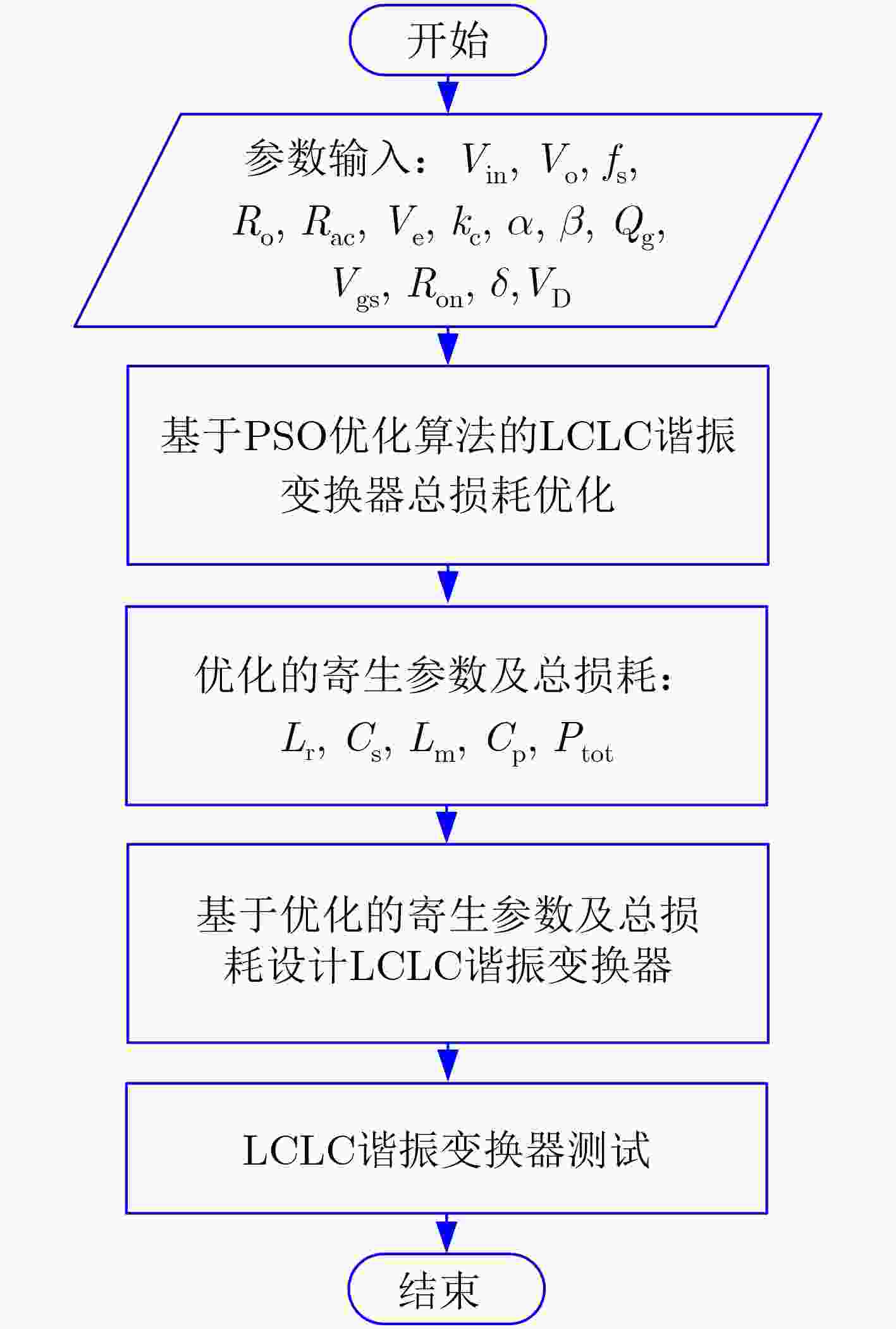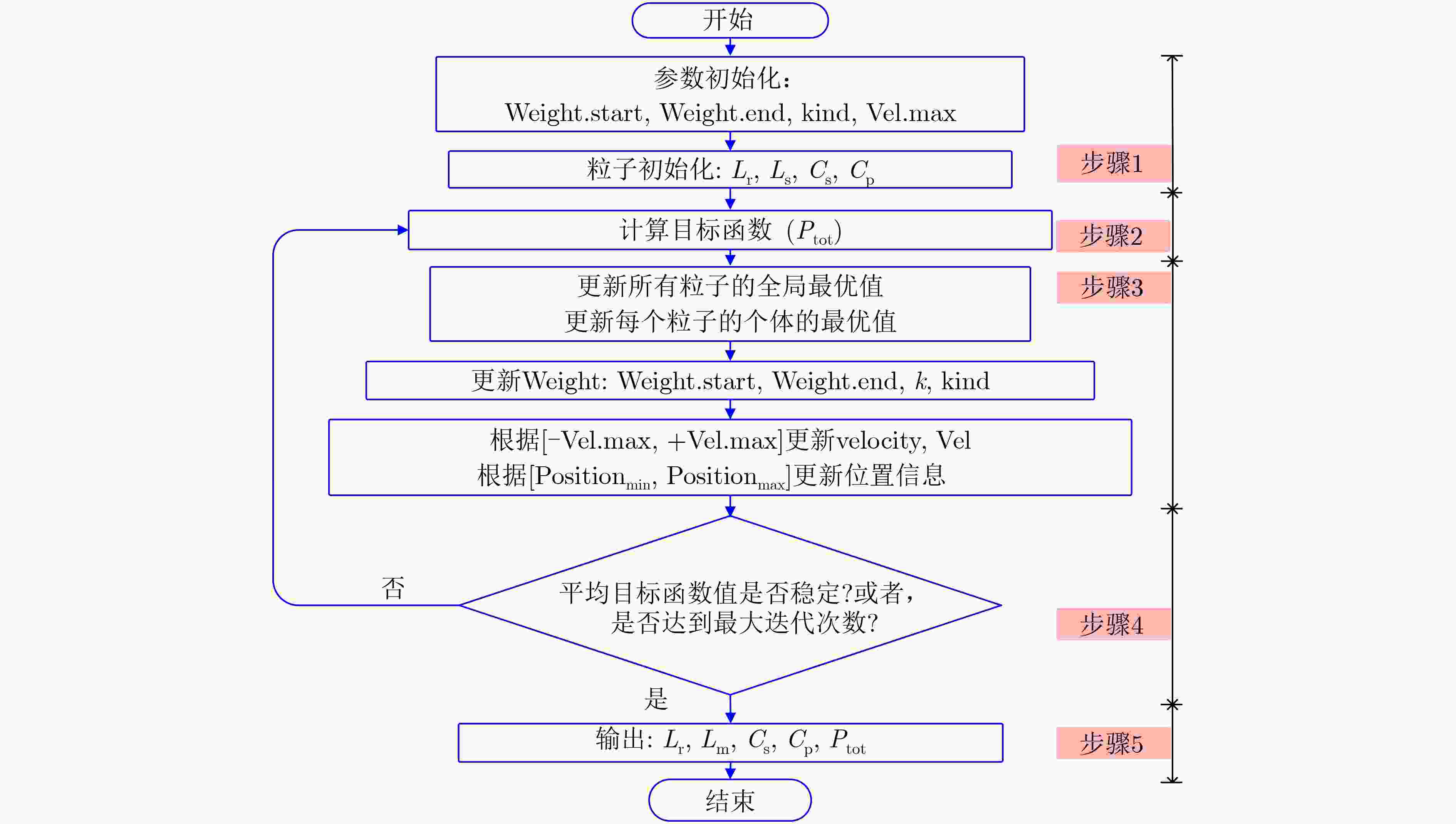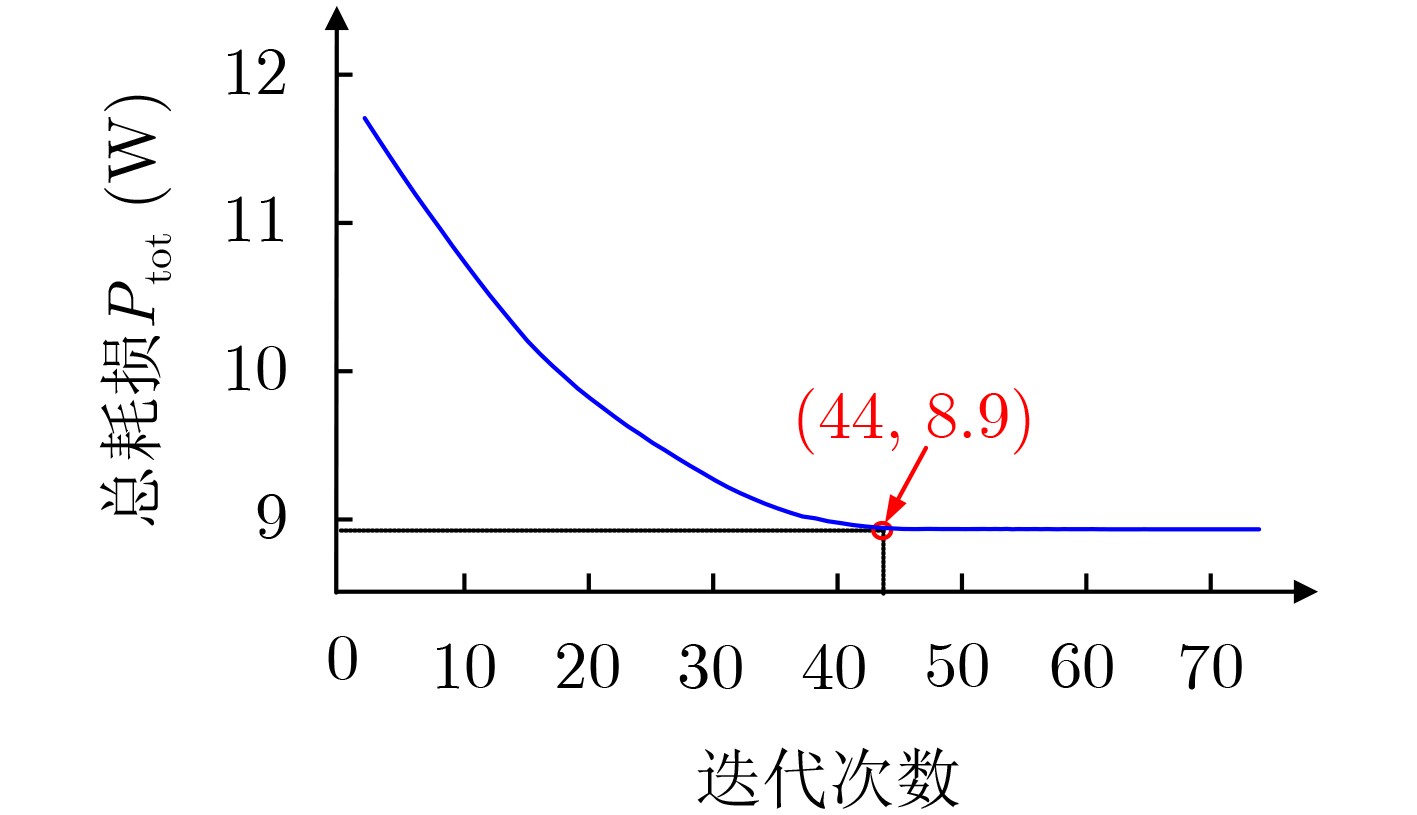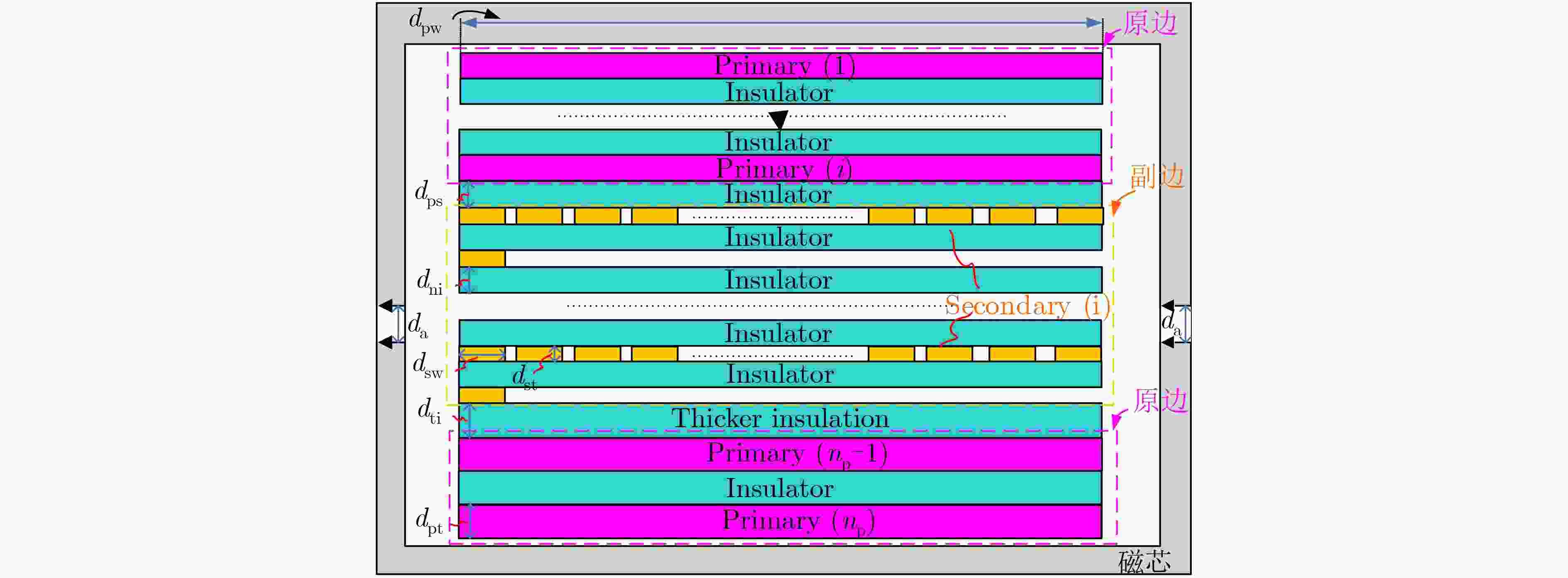Optimal Design Method of the LCLC Resonant Converter Based on Particle-Swarm-Optimization Algorithm
-
摘要: LCLC谐振变换器广泛应用在空间行波管放大器(TWTA)中,起到升压的作用。在LCLC谐振变换器中,具有多个谐振参数,即变压器漏感、串联谐振电容、励磁电感以及并联谐振电容。多个谐振参数增加了LCLC谐振变换器总损耗优化的难度。该文提出一种基于粒子群优化算法的LCLC谐振变换器优化设计方法,解决LCLC谐振变换器由于多个谐振参数造成的总损耗优化困难的问题。首先,推导了LCLC谐振变换器的总损耗公式;其次,采用粒子群优化算法,对LCLC谐振变换器的总损耗进行了优化,得到了总损耗最小时的谐振变换器参数;最后,基于优化的LCLC谐振变换器参数,搭建了LCLC谐振变换器,并进行了一系列实验。实验结果证明了该优化设计方法的有效性。Abstract: The LCLC resonant converters are universally applied to the space Travelling-Wave Tube Amplifiers (TWTA), to boost the input voltage. In an LCLC resonant converter, several resonant components, including the leakage inductance, the serial resonant capacitor, the magnetizing inductance and the parallel resonant capacitor, are included in the resonant tank, which complicates the optimal design of total power loss in the LCLC resonant converter. In order to solve this problem, in this paper, a Particle-Swarm-Optimization (PSO)algorithm based, optimal design method of the LCLC resonant converter is proposed. At first, the total power loss of the LCLC resonant converter is derived based on the circuit analysis; After that, the total power loss of the LCLC resonant converter is optimized by the Particle-Swarm-Optimization algorithm and the optimal resonant parameters are calculated. Finally, based on the optimal resonant parameters, the optimal LCLC resonant converter is built. The proposed optimal design method is validated by experiments.
-
表 1 LCLC谐振变换器参数
参数名称 参数值 参数名称 参数值 Vin 40 V Ve 10200 mm3 Vout 4800 V Ae 190 mm2 fs 300 kHz kc 3.716×10–24 Ro 80 kΩ α 4.823 Vgs 10 V β 5.521 Qg 40 nC Ron 4.5 mΩ Coss 660 pF Rac 20.0 mΩ 表 2 高压平面变压器参数
参数名称 描述 参数值 dps 变压器原边和副边之间的距离 0.13 mm dpt 初级绕组厚度 0.2 mm dst 次级绕组厚度 70 µm da 气隙厚度 63 µm dpw 初级绕组宽度 9.6 mm dsw 次级绕组宽度 0.28 mm dti 加厚绝缘层厚度 1.6 mm dni 常规绝缘层厚度 0.3 mm 表 3 仿真结果与优化结果的对比
参数名称 仿真结果 优化设计结果 Lr 0.09 µH 0.09 µH Lm 8.1 µH 8.0 µH Cp 13.0 nF 13.2 nF -
[1] NICOL E F and ROBISON J M. TWTA on-orbit reliability for satellite industry[J]. IEEE Transactions on Electron Devices, 2018, 65(6): 2366–2370. doi: 10.1109/TED.2018.2802868 [2] ZHAO Bin, ZHANG Xin, and ZHANG Zhe. Sequential Offline-Online-Offline (SO3) measurement approach for high-frequency LCLC resonant converters in the TWTA applications[J]. IEEE Transactions on Industrial Electronics, 2020, 67(2): 1568–1579. doi: 10.1109/TIE.2019.2898601 [3] 赵斌, 王刚, 王东蕾, 等. 空间行波管用LCLC谐振变换器的研究[J]. 电子与信息学报, 2017, 39(2): 482–488. doi: 10.11999/JEIT160334ZHAO Bin, WANG Gang, WANG Donglei, et al. Application of LCLC resonant converters for space travelling-wave tube amplifiers[J]. Journal of Electronics &Information Technology, 2017, 39(2): 482–488. doi: 10.11999/JEIT160334 [4] 赵斌, 王刚, 王东蕾. LCLC谐振变换器谐振电流的研究[J]. 电子与信息学报, 2017, 39(6): 1479–1486. doi: 10.11999/JEIT160752ZHAO Bin, WANG Gang, and WANG Donglei. Research on the resonant current of the LCLC resonant converters[J]. Journal of Electronics &Information Technology, 2017, 39(6): 1479–1486. doi: 10.11999/JEIT160752 [5] WANG Jianmin, TZENG L, HSU M T, et al. A simple control scheme to avoid the sensing noise for the DC–DC buck converter with synchronous rectifier[J]. IEEE Transactions on Industrial Electronics, 2018, 65(6): 5086–5091. doi: 10.1109/TIE.2017.2772195 [6] LU Weiguo, CHEN Weiming, RUAN Yixiao, et al. An auxiliary-parallel-inductor-based sequence switching control to improve the load transient response of buck converters[J]. IEEE Transactions on Industrial Electronics, 2019, 66(4): 2776–2784. doi: 10.1109/TIE.2018.2844847 [7] VEERACHARY M. Analysis of minimum-phase fourth-order buck DC–DC converter[J]. IEEE Transactions on Industrial Electronics, 2016, 63(1): 144–154. doi: 10.1109/TIE.2015.2472525 [8] KHAN A A and CHA H. Dual-buck-structured high-reliability and high-efficiency single-stage buck–boost inverters[J]. IEEE Transactions on Industrial Electronics, 2018, 65(4): 3176–3187. doi: 10.1109/TIE.2017.2752145 [9] DE LEÓN-ALDACO S E, CALLEJA H, and ALQUICIRA J A. Metaheuristic optimization methods applied to power converters: A review[J]. IEEE Transactions on Power Electronics, 2015, 30(12): 6791–6803. doi: 10.1109/TPEL.2015.2397311 [10] ZHAO Bin, ZHANG Xin, and HUANG Jingjing. AI algorithm-based two-stage optimal design methodology of high-efficiency CLLC resonant converters for the hybrid AC-DC microgrid applications[J]. IEEE Transactions on Industrial Electronics, 2019, 66(12): 9756–9767. doi: 10.1109/TIE.2019.2896235 [11] HEBALA O M, ABOUSHADY A A, AHMED K H, et al. Generic closed-loop controller for power regulation in dual active bridge DC–DC converter with current stress minimization[J]. IEEE Transactions on Industrial Electronics, 2019, 66(6): 4468–4478. doi: 10.1109/TIE.2018.2860535 [12] LEE J H, SONG J, KIM D W, et al. Particle swarm optimization algorithm with intelligent particle number control for optimal design of electric machines[J]. IEEE Transactions on Industrial Electronics, 2018, 65(2): 1791–1798. doi: 10.1109/TIE.2017.2760838 [13] BANERJEE S, GHOSH A, and RANA N. An improved interleaved boost converter with PSO-based optimal type-III controller[J]. IEEE Journal of Emerging and Selected Topics in Power Electronics, 2017, 5(1): 323–337. doi: 10.1109/JESTPE.2016.2608504 [14] ZHAO Bin, WANG Gang, and HURLEY G. Analysis and performance of LCLC resonant converters for high-voltage high-frequency applications[J]. IEEE Journal of Emerging and Selected Topics in Power Electronics, 2017, 5(3): 1272–1286. doi: 10.1109/JESTPE.2017.2687398 [15] ZHAO Bin, OUYANG Ziwei, DUFFY M C, et al. Andersen. An improved partially interleaved transformer structure for high-voltage high-frequency multiple-output applications[J]. IEEE Transactions on Industrial Electronics, 2019, 66(4): 2691–2702. doi: 10.1109/TIE.2018.2840499. -






 下载:
下载:










 下载:
下载:
